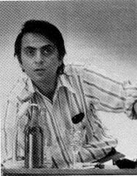|

Carl Segan
1934-1996
|
“We are a way for the universe to know itself. Some part of our being knows this is where we came from. We long to return, and we can, because the cosmos is also within us. We are made of star stuff.”
Carl Segan
December 20, 1996, the world of science was rocked by the passing of a great teacher, Carl
Sagan. A Professor of Astronomy, Space Sciences, and director of the Laboratory for Planetary Studies at Cornell University, where he
had held a professorship since 1971.
Carl Sagan highly believed in the exploration of space. In fact, I believe his contribution to the exploration of our Solar System goes unmatched. Listed below are some of the unmanned missions he has contributed to.
-
Mariner 9
spacecraft, which produced the first detailed images showing that Mars is currently a desolate, cratered
world.
-
Viking
orbiters and landers, which searched (unsuccessfully) for life on the surface of the Red Planet.
-
Pioneer and Voyager probes that
provided the first surveys of the outer planets and their moons.
-
Galileo craft, which is currently
sending back extremely detailed images of Jupiter and its giant
satellites.

Sagan at the SETI (Search for Extraterrestrial
Intelligence) Conference in 1972.
|
|
For many, me included, Sagan created a spark and interest in understanding the earth and our place in the cosmos. He toke a once held belief that the surface of Venus was possibly a hospitable place and showed us that in fact it was a hot and fried by a runaway greenhouse effect. But, he also showed that the universe was also full of beauty and is full of carbon-based
chemicals that could be the beginning of other living things. Carl Sagan also gathered evidence that Saturn's moon Titan has an atmosphere
containing organic molecules similar to the building blocks of life. All this was confirmed by Voyagers 1 and 2 in the 1980s.
Sagan like many of his followers believed in the existence of Extraterrestrial
life. At Cornell, he pioneered the new field of exobiology--the
study of possible alien biochemistry and life forms. He conceived a message plaque,
containing a greeting from the people of Earth, which adorns the Pioneer 10
spacecraft, now headed into interstellar space (a more sophisticated, engraved phonograph record
adorned the two
Voyager craft, also on their way to the stars). Along with various
collaborators, including Paul Horowitz
of Harvard University, Sagan supported projects that use radio telescopes to
listen for signals from possible intelligent
alien civilizations.
But perhaps Sagan's greatest skill was his ability to communicate with
individuals here on Earth. Through a series of books, magazine articles and
television shows, he reached beyond the scientific community to convey the
excitement of his research to the lay public. (His writing graced the pages of
Scientific American; three of his articles are available from this page.)
Sagan's concerns ranged far and wide, from the effects of nuclear war to the
evolution of the mind to the intellectual
erosion brought about by pseudoscience (the subject of his most recent book,
The Demon-Haunted World). His television series Cosmos
reached an estimated audience of 500 million people; his novel Contact is
being made into a movie that will be released later this year. Sagan also
co-founded the Planetary Society, the
largest space-interest group in the world.
RELATED LINKS:
From Scientific American:
"The Search for Extraterrestrial Life" by Carl
Sagan; Scientific American, October 1994
"The Solar System" by Carl Sagan; Scientific
American, September 1975
"The Search for Extraterrestrial Intelligence"
by Carl Sagan and Frank Drake; Scientific American, May 1975
Sources:
Scientific American
Sagan
remembrance from the Planetary Society
Carl Sagan obituary from
CNN
All copyrights remain property of their respective owners.